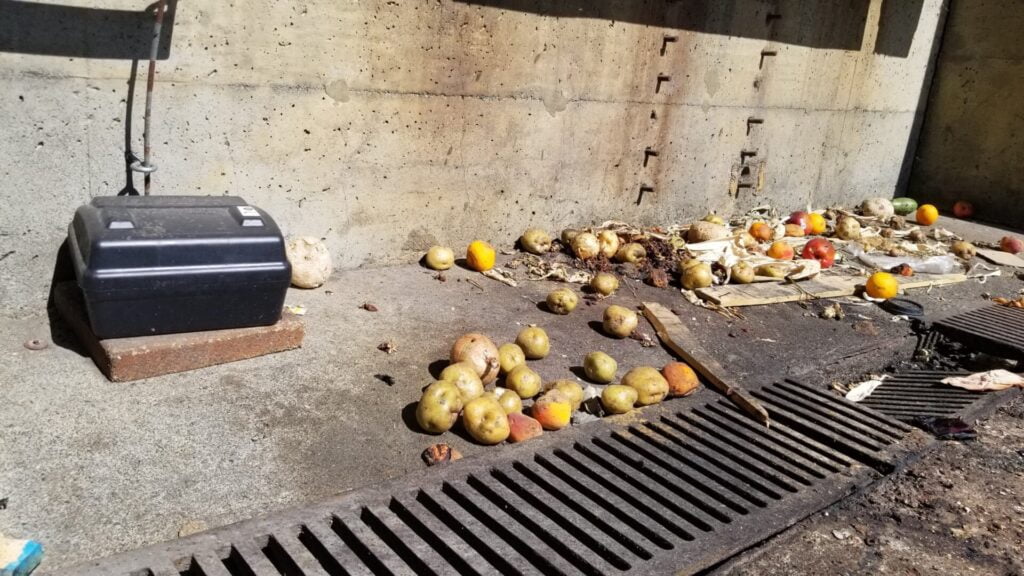People Don’t Know What They Are Buying
It is sold to people as the most economical way to manage rodent populations and prevent problems, and the efficacy of the product outweighs any potential unethical or inhumane outcomes, or environmental harm. People, businesses, and especially policymakers need to know that besides being incredibly inhumane and harmful, rodenticides do not work.
First, you should see how nasty this poison is, then you should read about this massive scam propped up by an agenda of profit, fear, and ignorance by large pest control corporations.
Here Is A Poisoned Rat Having Its Last Breaths
The following video is graphic, it shows a very sick rat and it’s dead and dying family. Watch at your own risk.
https://humanesolutions.ca/wp-content/uploads/2023/03/Poisoned-Rat-Video.mp4
So yes, it is nasty stuff. They die from internal hemorrhaging, inability to breath, seizures, etc.. Pest control companies and suppliers like to say that they die quickly and they will not die inside your structure, as the poison drives them to exterior water sources.
The reality is that the death is horrific and more than often the rodents will die and decay in an enclosed space like their nest, which is often in human structures. Beyond that, any carcass in the open is a poison trojan horse, basically guaranteed to kill the bird of prey, predator, or scavenger that finds it.

The Rodenticide Scam
Rodents are a multi-billion problem, and globally we spend billions on rodenticides to combat it. Governments, businesses, and even homeowners around the world have experienced the same trend: increased poison budgets have not resulted in declining rodent problems.

The industry standard is to implement untargeted, recurring rodenticide programs. Companies neglect to address the root cause, which is a passive effort to perpetuate the problem in order to convert every rodent problem into a source of recurring revenue.
When the results promised to you aren’t realized, they can respond with “you need more poison” and there is little you can do about it.
What About All The Rodents Not Eating Poison?
Your problem isn’t that there are 20 rats in your attic, it’s that there is any rats in your attic. Would you be satisfied if you inhumanely killed 80% of them (which could be rotting anywhere on your property) and now there are only 5 left up there? No.
Many rodents will simply avoid rodenticides after initial contact, if not build immunity completely. Most rodents in urban environments are alive only because they have learned to actively avoid control devices like poison stations.

Rodenticides Rob Us Of Data
The very nature of delayed-onset rodenticides prevents any meaningful data collection – it is difficult to study an animal that can randomly die at any given time, in a location it can’t be retrieved. Additionally, any study attempted in a real-world setting will be contaminated by rodenticides.
Due to the lack of meaningful data collection and utilization, little innovation or sustainable development has been made in the rodent industry since the inception of modern rodenticides a century ago.
Pest control companies are unethically profiting from a service that perpetuates the problem instead of solving it.

We Are Subscribed To Rodenticides Even Though We Aren’t Satisfied
There is hardly a satisfied consumer of poison services, as they pay endlessly for a problem that never truly subsides. People, businesses, and governments around the world are reluctantly subscribed to this service and methodology because a viable alternative is not available to them.
Policymakers understand that the industry standard is not working, and they are realizing they cannot justify spending millions of taxpayer money on a service that fails to deliver a result and degrades the environment. Furthermore, – due to the lack of data – policymakers currently rely on reports from companies like Orkin to inform pest control policy. The only option they have is to continue with the ineffective poison, simply to show “due diligence” through budget spend.

We Lose Billions Due To Ineffective Rodent Control
Few people know the scope of the problem, as the industry and the numbers are in that category of out of sight out of mind, like sewage. It’s bad, and there data is there.
- Rodents consume or contaminate a minimum of 20% of the global food supply
- Rodents cost a minimum of $20 billion a year in the US, due to resource loss, damage, and cost to control
- India loses more than 25% of its postharvest grain to rodents, at a cost greater than $5 billion
- In 1982, commensal rodents already cost the world’s economy more than US$300 billion
The global rodent problem is one of the most costly and serious facing society today. Shrouded in intentional ignorance and misinformation, we have allowed the problem to grow to nearly immeasurable economic, environmental, and social cost.
We Waste Billions Failing To Control Rodents With Rodenticides
With their never-ending, results-less services, pest control companies are raking it in.
DIYers, businesses, and industry are in the same position; rodents plague everyone from homeowners to businesses and large-industry, and they are all receiving the same inhumane, ineffective service in response.
- The global pest control market size was valued at USD 22.21 billion in 2021. It is projected to reach USD 35.05 billion by 2030, growing at a CAGR of 5.2% during the forecast period (2022–2030)
- The United States pest control industry was estimated to have a market value of over 20.3 billion U.S. dollars in 2022.
The problem is too big to sweep under the rug, pest control companies need to be regulated and held accountable for negligence.
Rodenticides Degrade Our Ecosystems
There’s no safe place or safe delivery system for second-generation rodenticides. After a rodent partakes, it stumbles around for three to four days, displaying itself as an especially tempting meal not just for raptors but for mammalian predators, including red foxes, gray foxes, endangered San Joaquin kit foxes, swift foxes, coyotes, wolves, raccoons, black bears, skunks, badgers, mountain lions, bobcats, fishers, dogs, and house cats—all of which suffer lethal and sublethal secondary poisoning from eating rodents.
In California, the only state other than New York that has looked carefully, rodenticides showed up in 79 percent of fishers (one fisher even transferred poisons to her kit via her milk), 78 percent of mountain lions, 84 percent of San Joaquin kit foxes, and, in San Diego County, 92 percent of raptors.

Rodenticides Harm People And Pets
Hey, don’t forget the puppies and children, the cherry on top.
- 10,000 children every year are harmed by rodenticide contact in the US
- Most of these incidents are children under the age of 3
- Over 20% Latino, and over 50% African American
- 15,000 calls per year come into the Centers for Disease Control from parents whose children have eaten rodenticides
- Poisoning from rodenticides (mouse and rat poisons) is one of the most common types of toxicities managed by the Pet Poison Helpline
Conclusion
From rodenticide use on individual properties, to commerical operations, to entire regions and countries, the result is the same and the data shows we should have divested a long time ago. There is so much opportunity in finding results beyond rodenticides, I believe the way forward is to focus on root causes and invest in young innovators working in the space.
